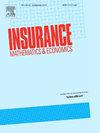用于总索赔建模的贝叶斯CART模型
IF 2.2
2区 经济学
Q2 ECONOMICS
引用次数: 0
摘要
本文提出了索赔总额的三种贝叶斯CART(或BCART)模型,即频率-严重性模型、顺序模型和联合模型。我们提出了一个适用于具有多变量响应数据的BCART模型的通用框架,这对于具有双变量响应的联合BCART模型特别有用:索赔数量和总索赔金额。为了方便频率-严重程度建模,我们使用不同的分布研究了右偏和重尾索赔严重程度数据的BCART模型。我们发现威布尔分布优于伽马和对数正态分布,因为它能够在树模型中捕获不同的尾部特征。此外,我们发现顺序BCART模型和联合BCART模型是有益的,它们可以在索赔数量和严重性之间包含更复杂的依赖关系,因此比通常假设独立性的频率-严重性BCART模型更可取。通过精心设计的仿真和真实的保险数据,说明了这些模型的有效性。本文章由计算机程序翻译,如有差异,请以英文原文为准。
Bayesian CART models for aggregate claim modeling
This paper proposes three types of Bayesian CART (or BCART) models for aggregate claim amount, namely, frequency-severity models, sequential models and joint models. We propose a general framework for BCART models applicable to data with multivariate responses, which is particularly useful for the joint BCART models with a bivariate response: the number of claims and the aggregate claim amount. To facilitate frequency-severity modeling, we investigate BCART models for the right-skewed and heavy-tailed claim severity data using various distributions. We discover that the Weibull distribution is superior to gamma and lognormal distributions, due to its ability to capture different tail characteristics in tree models. Additionally, we find that sequential BCART models and joint BCART models, which can incorporate more complex dependence between the number of claims and severity, are beneficial and thus preferable to the frequency-severity BCART models in which independence is commonly assumed. The effectiveness of these models' performance is illustrated by carefully designed simulations and real insurance data.
求助全文
通过发布文献求助,成功后即可免费获取论文全文。
去求助
来源期刊

Insurance Mathematics & Economics
管理科学-数学跨学科应用
CiteScore
3.40
自引率
15.80%
发文量
90
审稿时长
17.3 weeks
期刊介绍:
Insurance: Mathematics and Economics publishes leading research spanning all fields of actuarial science research. It appears six times per year and is the largest journal in actuarial science research around the world.
Insurance: Mathematics and Economics is an international academic journal that aims to strengthen the communication between individuals and groups who develop and apply research results in actuarial science. The journal feels a particular obligation to facilitate closer cooperation between those who conduct research in insurance mathematics and quantitative insurance economics, and practicing actuaries who are interested in the implementation of the results. To this purpose, Insurance: Mathematics and Economics publishes high-quality articles of broad international interest, concerned with either the theory of insurance mathematics and quantitative insurance economics or the inventive application of it, including empirical or experimental results. Articles that combine several of these aspects are particularly considered.
 求助内容:
求助内容: 应助结果提醒方式:
应助结果提醒方式:


